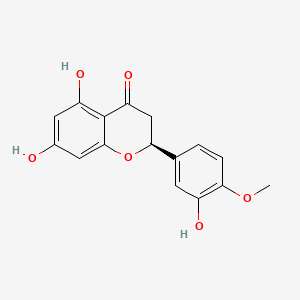| MeSH term | MeSH ID | Detail |
|---|---|---|
| Mammary Neoplasms, Animal | D015674 | 27 associated lipids |
| Lymphoma, B-Cell | D016393 | 24 associated lipids |
hesperetin
Hesperetin is a lipid of Polyketides (PK) class. Hesperetin is associated with abnormalities such as Corn of toe, Ischemia, Osteoporosis, Consumption-archaic term for TB and Wiskott-Aldrich Syndrome. The involved functions are known as conjugation, inhibitors, Process, mRNA Expression and Adjudication. Hesperetin often locates in Entire intestinal epithelium, Protoplasm, Membrane, Shoulder and Back. The associated genes with Hesperetin are ABCG2 gene, ABCC2 gene, FATE1 gene, ABCB1 gene and P-glycoprotein 2.
Cross Reference
Introduction
To understand associated biological information of hesperetin, we collected biological information of abnormalities, associated pathways, cellular/molecular locations, biological functions, related genes/proteins, lipids and common seen animal/experimental models with organized paragraphs from literatures.
What diseases are associated with hesperetin?
hesperetin is suspected in Corn of toe, Ischemia, Osteoporosis, Diabetes and other diseases in descending order of the highest number of associated sentences.
Related references are mostly published in these journals:
| Disease | Cross reference | Weighted score | Related literature |
|---|
Possible diseases from mapped MeSH terms on references
We collected disease MeSH terms mapped to the references associated with hesperetin
PubChem Associated disorders and diseases
What pathways are associated with hesperetin
There are no associated biomedical information in the current reference collection.
PubChem Biomolecular Interactions and Pathways
Link to PubChem Biomolecular Interactions and PathwaysWhat cellular locations are associated with hesperetin?
Visualization in cellular structure
Associated locations are in red color. Not associated locations are in black.
Related references are published most in these journals:
| Location | Cross reference | Weighted score | Related literatures |
|---|
What functions are associated with hesperetin?
Related references are published most in these journals:
| Function | Cross reference | Weighted score | Related literatures |
|---|
What lipids are associated with hesperetin?
There are no associated biomedical information in the current reference collection.
What genes are associated with hesperetin?
Related references are published most in these journals:
| Gene | Cross reference | Weighted score | Related literatures |
|---|
What common seen animal models are associated with hesperetin?
There are no associated biomedical information in the current reference collection.
NCBI Entrez Crosslinks
All references with hesperetin
Download all related citations| Authors | Title | Published | Journal | PubMed Link |
|---|---|---|---|---|
| Pereira-Caro G et al. | Catabolism of citrus flavanones by the probiotics Bifidobacterium longum and Lactobacillus rhamnosus. | 2018 | Eur J Nutr | pmid:27722779 |
| González-Alfonso JL et al. | Optimization of Regioselective α-Glucosylation of Hesperetin Catalyzed by Cyclodextrin Glucanotransferase. | 2018 | Molecules | pmid:30400664 |
| Sak K et al. | Suppression of Taxanes Cytotoxicity by Citrus Flavonoid Hesperetin in PPC-1 Human Prostate Cancer Cells. | 2018 | Anticancer Res. | pmid:30396939 |
| Park JH et al. | Hesperetin mitigates acrolein-induced apoptosis in lung cells in vitro and in vivo. | 2018 | Redox Rep. | pmid:30325253 |
| Samie A et al. | Hesperetin, a citrus flavonoid, attenuates testicular damage in diabetic rats via inhibition of oxidative stress, inflammation, and apoptosis. | 2018 | Life Sci. | pmid:30179627 |
| Meng C et al. | Preventive effect of hesperidin modulates inflammatory responses and antioxidant status following acute myocardial infarction through the expression of PPAR‑γ and Bcl‑2 in model mice. | 2018 | Mol Med Rep | pmid:29115547 |
| Mary Lazer L et al. | Chitosan-based nano-formulation enhances the anticancer efficacy of hesperetin. | 2018 | Int. J. Biol. Macromol. | pmid:29032208 |
| Loizzo MR et al. | Ruta chalepensis L. (Rutaceae) leaf extract: chemical composition, antioxidant and hypoglicaemic activities. | 2018 | Nat. Prod. Res. | pmid:28486828 |
| Liu T et al. | Production of drug nanosuspensions: effect of drug physical properties on nanosizing efficiency. | 2018 | Drug Dev Ind Pharm | pmid:28956456 |
| Li Y et al. | Drug interaction study of flavonoids toward CYP3A4 and their quantitative structure activity relationship (QSAR) analysis for predicting potential effects. | 2018 | Toxicol. Lett. | pmid:29753067 |
